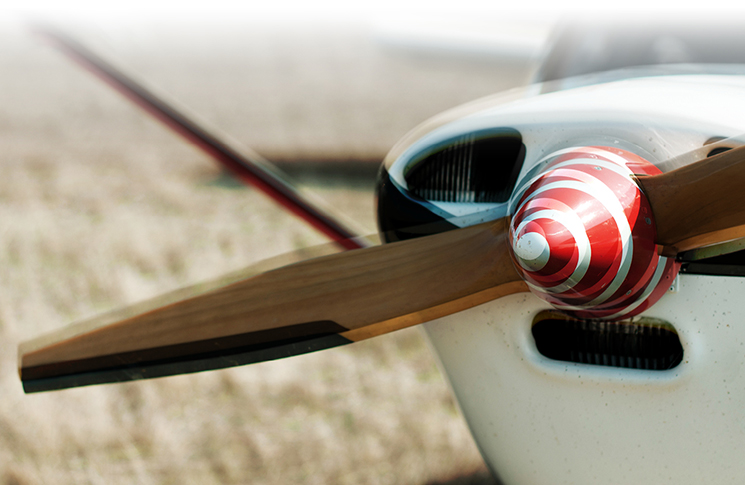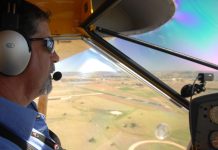I’d known for ages that my propeller had a small split at one end. I made some inquiries and learnt that new props were around $2,000. I just did not want to pay that, so I kept repairing it with an epoxy glue – which so far had been working. I had read that other people had done the same thing.
Anyway, on a Wednesday in August, I had no work on, so I thought I’d take a quick flight over to my mate’s place near Bacchus Marsh.
When I landed, he was still in his car, about 5 minutes away. So, I walked around inspecting my aircraft. I topped up the oil and checked this and that. In my walk around, I noticed the split on the prop had opened a little on one side and was now some centimetres long! Ahhhhhhhh … what the hell, I thought.
I showed it to my friend, and he said he wouldn’t fly with the propellor like that! Of course, I didn’t want to be stranded there and if I had some glue with me, I would have applied more. In the end I thought, ‘Well, the aircraft got me here with no sign of any drama so it should get me home again.’
I thought that after I’d landed back at my home airfield, I’d remove the prop and take it home for a closer look and repair. So, in the meantime, I got some heavy-duty duct tape and taped the damaged end.
I was painfully aware that the prop could completely disintegrate at any moment.
Now, on reflection – what was I thinking by trying to duct tape a damaged prop? Still, at the time I guess I wanted to rationalise it, and because I wanted it to – it made sense.
When it was time to leave, I started up, taxied and departed, absolutely no problem. I flew for maybe 25 minutes by which time I was just approaching the coastline adjacent to the city. Then I heard it – a very loud brrrrrrrr noise!
At first, I thought it was static on the radio and turned it down but that didn’t fix the problem. My next thought was there was a problem with the engine. Within seconds, I realised the truth – it was the damaged prop starting to delaminate mid-flight!
The vibration of the now unbalanced prop started to kick in and the noise became louder and louder. If I didn’t have noise cancelling headphones, the noise from the prop would have been even scarier. I was having prop trouble near a major built-up area, filled with oil refineries and such!
I considered calling in an emergency or even a pan-pan, but I didn’t want undue attention, and the prop was still producing thrust, albeit with noise. I was painfully aware that the prop could completely disintegrate at any moment. As I looked around desperately for someplace to land, I thought about landing on the beach. The trouble with the beach, besides rocks, fences and people, was that we were in the middle of a wet winter and the beach could have acted like quicksand.
I decided not to land on the beach or a road or park. I called my mate and told him of my problem and said I was heading back to his field. I didn’t really expect to make it all the way back there, but I wanted to at least try to clear the major built-up area and get back to open land.
One problem was I was already on the correct height for crossing the bay which, in my direction, was only 1,500 feet. As I turned around to start back, I throttled back from 2,850 rpm (normal cruise speed in my aircraft) to 2,000 rpm, to have less stress on the prop. After trimming the aircraft, I could maintain height, albeit at a very compromised 60-knots indicated airspeed.
As I throttled back, the noise was lower but the vibration worse, so I just had to deal with that. I was pretty much expecting what was left of the prop would just break apart mid-air.
However, despite the noise and vibration, the prop was still providing thrust and, therefore, producing lift, so I continued to fly. I thought, God willing, I’ll get back to the field. If not, I’d be able to do a pan-pan call and land in a paddock, hopefully with no damage or injury.
As it happened, by keeping the rpm low, I managed to make it back to my departure point. On short final, when I powered back nearly to idle to increase my rate of descent, the vibration went through the roof … bloody hell! But I did get it safely on the ground and taxied back to the hanger, while the prop was vibrating like crazy.
When I shut down and got out, the first thing I did was look at the prop, of course. Surprisingly, it wasn’t anywhere near as bad as I had imagined from the noise or vibration. It made me think there might still be a problem that had just developed in the engine and the vibration was not due to prop. I wouldn’t know that until I put a new prop on.
I also discovered the other side of the prop was starting to open. So, yes, that prop had definitely reached its use-by date. I immediately ordered a new original equipment Bolly prop at $2,100. Ouch, but better that than dying. 
Lessons learnt
Aviation isn’t cheap and if you try do it on the cheap, you can end up making it more dangerous.
I had an undiagnosed but clear case of get-home-itis. This unconscious bias affected my judgement.
In retrospect I should have called pan-pan earlier. There’s no penalty for doing so and it might have made the difference to search and rescue if I hadn’t made it to the field. I suppose I was doing aviate-navigate-communicate but I still could – and should – have said something.
Non-controlled operations is one of the special topics on our Pilot safety hub. Refresh your knowledge at casa.gov.au/pilots.
See also the Aviation decision-making card at casa.gov.au
Have you had a close call?
Eight in 10 pilots say they learn best from other pilots and your narrow escape can be a valuable lesson. We invite you to share your experience to help us improve aviation safety, whatever your role. Find out more and share your close call.
Disclaimer
Close calls are contributed by readers like you. They are personal accounts of individual experiences and are not corroborated by CASA. We publish close calls so others can learn from their stories and spark discussions about safety. These stories should not be used to identify individuals or operators.






I am dumfounded that any qualified (?) pilot would not understand the ramifications of :
1. A wooden/composite prop starting to delaminate (split)
2. Effecting such amateur repairs (epoxy?) on a prop tip that must be traveling a just sub sonic speeds when under high power.
3. Adding weight (tape) to one blade ie creating a massive out of balance situation.
4. Of continuing a flight, rather than making an out landing ASAP, with a seriously out of balance prop – could so easily have caused the engine to depart the airframe – one dead pilot!
Sean JB Griffin . . . Glad you wrote this comment. I wanted to write something similar or probably more detailed, based on holding an FAA Aircraft Mechanic Licence for Airframe and Propeller and was an Army-trained Maintenance Test Pilot, but often when I point out too much truth or reality it never gets published.
The tape, while useless, will not cause any out of balance, let alone a ‘massive out of balance’.!
With the wisdom of hindsight, the price of a new prop was very cheap compared with the anxiety and stress incurred on this flight. Even cheaper if the worst possible outcome had occurred.
Thanks for posting.
I am dumbfounded that any Australian pilot licence holder would not know the CIVIL AVIATION REGULATIONS 1988, Schedule 8, maintenance that can be carried out on a B class aircraft by a pilot.
Who was the pilot’s Flying Instructor? Did the Flying Instructor know that regulation or teach that. And, if the pilot did not know that, what else doesn’t he know? It all comes down to training.
After the epoxy repair had shown itself to be ineffective the correct path is to stop trying to repair the prop and obtain a serviceable part. Repairs on top of repairs, especially with glue, are a folly. The ‘free’ get out of trouble spot was before the last take off, the ‘prop got me here’ should have been akin to a ‘thank you for your service’.. The out-of-balance flight back will have placed stress on the engine crank snout, the engine frame and mounts, prematurely wearing and stressing components which may also come back to cost more money, time or problems of their own.. Metal never forgets stress. Duct tape is an aerodynamic repair, not a structural repair, it added zero integrity to the prop and the pilot should have called it a day and gone had a nice pub meal with his mate to commiserate the expense of a new prop. Missing that opportunity was the last key warning in a field where warnings aren’t always so plentiful.
Thankyou to whoever had the guts to own up to doing a dumb and dangerous thing for the benefit of all of us. Not many in this game would dare to publicly own up to the last dumb and dangerous thing they did but we all know there probably was one.